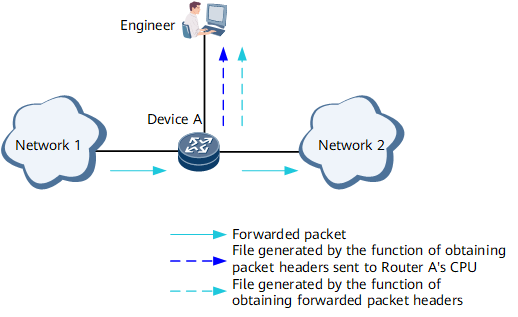Understanding Obtaining Packet Headers
Network engineers use the obtaining packet headers feature to obtain packet headers to be sent to central processing units (CPUs) or forwarded. Then they analyze the obtained headers to locate network faults. Figure 1 shows how to implement this feature.
- A network engineer logs in to Device A and configures a packet header obtain policy. This policy defines the interface on which packets will be obtained, access control list (ACL) rule, packet length, and timeout time.
- When Device A receives packets and sends the packets to its CPU or forwards packets, it replicates the packets based on the configured packet obtaining policy. It then generates an obtained packet file and stores this file on its compact flash (CF) card.
- The network engineer obtains this packet header obtain file to locate network faults.
The following table lists the differences between obtaining packet headers to be sent to CPUs and obtaining packet headers to be forwarded.
Item |
Obtaining Packet Headers Sent to CPUs |
Obtaining Forwarded Packet Headers |
|---|---|---|
Object |
Packets destined to CPUs |
Forwarded packets |
ACL Rule |
Supported ACLs:
|
Supported ACLs:
|
Impact on Performance |
Has no impact on system performance. |
Affects system forwarding performance. |
